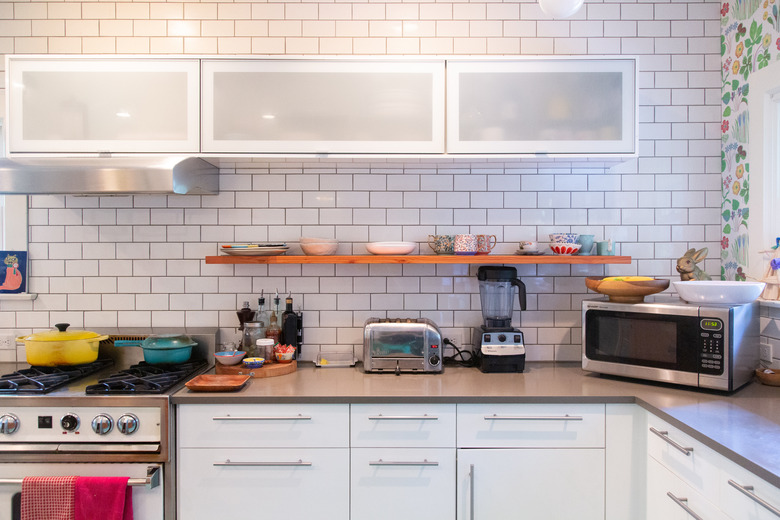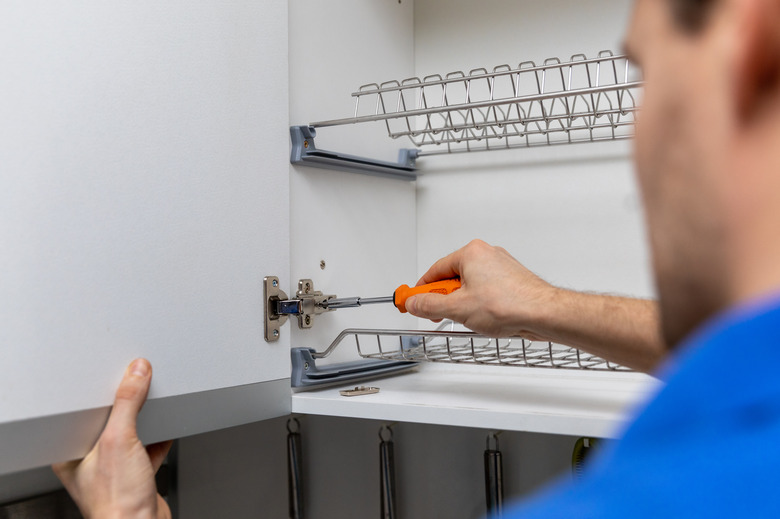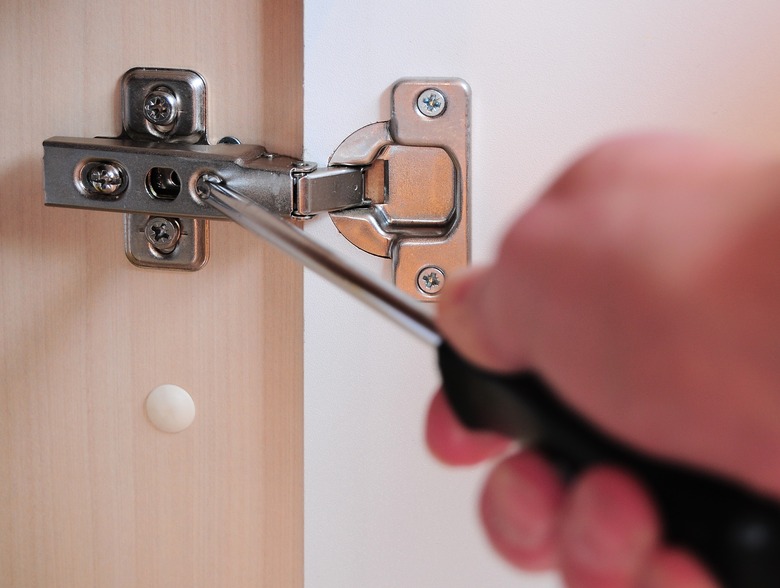How To Adjust Cabinet Doors
It's not easy to live with misaligned cabinet doors. From squeaks to bumps to rogue hinges, it can be exasperating to deal with cabinetry that just isn't sitting right. Luckily, though, adjusting kitchen cabinets can be a quick and easy DIY job. Learning more about cabinet adjustments can help you fix any errant hinges to get your doors working smoothly again.
Figuring Out Your Hinges
Figuring Out Your Hinges
Before you begin to realign your cabinet doors, determine what types of cabinet hinges you have. You'll see hinges referred to as Euro hinges and cup hinges, or hinge cups. The names get used interchangeably, but there are little differences between these types of hinges.
European style, or Euro hinges, are mounted onto the inside surface of bathroom or kitchen cabinets via a plate. Some hinges are mounted via a cup, typically referred to as a hinge cup, that gets drilled into the cabinet doors.
Both types are concealed hinges, meaning that they're hidden within the cabinet, and you can't see them when the doors are closed. The hinges typically have three adjustment screws for moving the door in different directions. An in-and-out adjustment moves the door toward or away from the cabinet box or frame, a side-to-side adjustment tilts the door sideways in either direction and an up-and-down adjustment moves the door vertically.
Most modern cabinets with Euro or cup hinges have the mechanisms that allow you to make all three types of adjustments. In older homes, Old House Journal notes that you might find exposed hinges, or hinges that are visible on the outside of the frame, that don't have the mechanisms to make adjustments in all three directions. In this case, for major adjustments, you may have to move the hinge entirely.
How to Get Started
How to Get Started
Spend a few minutes examining and experimenting with a single door and set of hinges to learn exactly what each adjustment screw does and how it affects the door's position. Note that two or more of the screws on each half of the hinge (the door half and cabinet half) are the mounting hinges that secure the hinge to the wood. In some cases, the mounting screws double as adjustment screws. This is usually indicated by elongated screw holes on the hinges. To make an adjustment on your kitchen cabinets, you'll need a Phillips screwdriver. First, determine which way you need to adjust. (It could be a few different ways.)
Making Side-to-Side Adjustments
Making Side-to-Side Adjustments
If a cabinet door is visibly leaning to one side or paired doors are rubbing against each other, you probably need to do a side-to-side adjustment. Use the screwdriver to loosen the mounting screws in the cabinet door, reposition the door and then tighten the screws. Alternatively, if the hinge has a side-to-side screw, simply rotate the screw in the desired direction. Close the door and check its fit with the cabinet or mating door. Readjust the hinge as needed.
Making In-and-Out Adjustments
Making In-and-Out Adjustments
You might find that the depth of your doors is off. This can happen with wood in humid climates or in areas that see a lot of steam, like bathrooms. If this is the case, you can make an in-and-out adjustment to make sure the doors sit flush with the face frame or cabinet box.
The plate with the in-and-out adjustment mechanism usually is the one furthest from the cabinet door. The more you tighten the screw, the closer the door will be to the frame. Note that you may have to adjust both the top and bottom hinge to create an even gap between the door and the cabinet. For instance, if a door doesn't meet the frame at the bottom, adjust it to bring the bottom hinge closer to the cabinet and adjust the top hinge to be farther away from the cabinet.
Adjusting Door Height
Adjusting Door Height
If your kitchen-cabinet doors are sitting too high or low, make small adjustments via the up-and-down adjustment screw or cabinet-mounting screws as applicable. Loosen the screws and move the door up or down and then tighten the screws after you've made your adjustment. As with side-to-side adjustments with door pairs, you may need to adjust both doors more than once to get them to align properly.
Tips for the Best Adjustments
Tips for the Best Adjustments
Always use a standard screwdriver, not a drill or power screwdriver, to make hinge adjustments. With a power tool, it's too easy to overtighten a screw, possibly damaging the hinge or stripping out the screw in the wood. A manual screwdriver gives you a much finer touch and allows you to make smaller adjustments.
Additionally, while this is doable as a one-person job, it might help to have another set of eyes and hands for the adjustments. One person can stand back to help direct the other to make sure the positioning is correct. An assistant can also help to hold a cabinet door steadily in place so the other person can focus solely on screwing the hinge.


